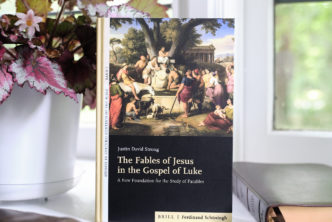
In 2017, David Pleins and I released a new resource designed for students of Biblical Hebrew: Biblical Hebrew Vocabulary by Conceptual Categories: A Student’s Guide to Nouns in the Old Testament (Zondervan, 2017), a user-friendly book from Zondervan that arranges Biblical Hebrew words and phrases into categories from water to warfare, from jars to genitalia. Since then, we’ve gotten positive reviews in several journals, including the Review of Biblical and Early Christian Studies, Journal for the Study of the Old Testament, Expository Times, Bulletin for Biblical Research, Review of Biblical Literature, and Hebrew Higher Education. This blog series at theLAB aims to show how this book can be useful for students of all levels.
Let’s say you’ve taken your first semester or two of Biblical Hebrew. You’re getting comfortable with the grammar but now are overwhelmed by the thousands of vocabulary words.
What’s your next step?
At some point in his decades of teaching Biblical Hebrew, David Pleins realized there was a gap in his students’ education. Once his students had mastered the basic grammar of the language, they were still unable to read with the level of fluidity that made the language of Scripture enjoyable. He assigned them the frequency-based handbooks of biblical Hebrew vocabulary: Landes, Van Pelt/Pratico, and Mitchel. But rote memorization does not build connections between vocabulary in Biblical Hebrew. And it’s hardly a motivating enterprise!
So David began organizing Biblical Hebrew vocabulary into lists of different conceptual categories: wine, body parts, professions, pots, and so forth. Linguists call these “semantic domains.” Though there are some amazing studies of specific semantic domains in Biblical Hebrew, most are locked away in highly technical literature, such as the Semantic Dictionary of Biblical Hebrew project or the Semantics of Ancient Hebrew Database.
Although biblical scholars such as John Hobbins called for a student-friendly condensation of this research, nobody had compiled such a students’ handbook of Biblical Hebrew vocabulary by semantic domains. Louw and Nida created a massive handbook of semantic domains for biblical Greek, the Greek-English Lexicon of the New Testament Based on Semantic Domains—condensed for students in Wilson and Oden’s Mastering New Testament Greek Vocabulary Through Semantic Domains. Yet no such resource exists for Biblical Hebrew, which has a far larger corpus than biblical Greek.
Pleins’ and my book, Biblical Hebrew Vocabulary by Conceptual Categories: A Student’s Guide to Nouns in the Old Testament, compiles roughly 2,300 words and phrases in Biblical Hebrew into a comprehensive handbook. Our work began with David’s own decades of teaching and learning Biblical Hebrew. I incorporated research into biblical Hebrew lexical semantics: titles such as Milton Eng’s The Days of Our Years: A Lexical Semantic Study of the Life Cycle in Biblical Israel and Philip Zhakevich’s The Tools of an Israelite Scribe: A Semantic Study of the Terms Signifying the Tools and Materials of Writing in Biblical Hebrew. Every entry in the book was checked against Clines’ Dictionary of Classical Hebrew and other lexica.
For example, see our subcategory “Cutting Instruments” under “Containers and Implements”:

In addition to the Hebrew lexeme, each entry contains three features:
- One or multiple English glosses;
- One Scripture reference, usually selected for its vividness or memorability;
- An “H” if the word is hapax and an “R” for rare if the word is used fewer than 10 times in the Bible. This alerts the reader to which are the low-frequency vocabulary and also alerts them that the definitions of words with an “H” or an “R” are much less certain.
The English glosses are drawn from both Pleins’ and my studies and from various authors, who may give different nuances. These are meant to be a brief sketch of a word’s meaning, not the final word. Many entries also contain references to scholarship that flesh out the meaning of the lexeme. For example, two items in this list reference Aaron Koller’s 2012 monograph, The Semantic Field of Cutting Tools in Biblical Hebrew: The Interface of Philological, Semantic, and Archaeological Evidence.
Pleins and I devised our own scheme of organization. We focused on terms drawn from daily life, rather than abstract ideas or emotions. Hence our book is very noun-heavy, though occasionally a verb or two sneaks its way in. To see a preview of the categories we devised, check out the table of contents.
We hope this resource proves as helpful to you as it was fun (!) to put together. In the next post, we’ll explore how you can use Biblical Hebrew Vocabulary by Conceptual Categories to deepen your understanding of biblical vocabulary.
Pleins and Homrighausen’s Biblical Hebrew Vocabulary by Conceptual Categories: A Student’s Guide to Nouns in the Old Testament is currently on pre-order for Logos, and will be fully integrated and tagged for the best research and study experience possible. Get in on the special pre-order pricing of $11.99 now.






Very nice Dr. Jonathan:
I already signed up to get a copy.
Just out of curiosity, have you thought of doing something similar to:
https://www.logos.com/product/3608/dictionary-of-latin-and-greek-theological-terms
But that includes: Hebrew and German, and English for comparison.
It would be great to have a handy reference that dealt with key theological words / phrases / concepts.
Could be done in a semantic domain kind, and that had Biblical Hebrew, Koine Greek, Ecclesiastical Latin, Theological German and English for comparison, so that it would facilitate theological work.
Thanks for your input on this ahead of time.
Hi Hamilton — thanks for buying a copy! However, I think the “Theological Lexicon of the Old Testsment” and the more compact “Theological Wordbook of the Old Testament” already cover what you describe, no?
1) This book is a great idea. I purchased the hard copy when it first came out in 2017. I am wondering if the digitized version will make it more useful. For example, will it be possible to export this vocabulary list to the Logos vocab app for my phone?
2) Also, the “Cluster Verses for Study” in appendix two would be very useful if the verses were all printed in the same place. I am assuming that with the digital version I could simply cut and paste the references into the “Copy Bible Verses” tool so that I could print out a study sheet. Is this the case?
3) Finally, this resource would be most helpful if it could be developed into a pictorial dictionary. Do you know of such a source or is anyone working on this? See for example (1) “Let’s Speak Spanish!” by by Katherine Farris and Linda Hendry or (2) Usborne’s “Beginner’s Spanish Dictionary” or (3) Vox’s “First Spanish Picture Dictionary”.